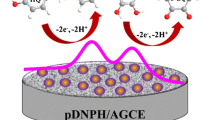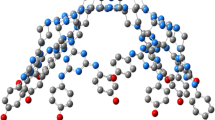Abstract
In this paper, 9,10-anthraquinone (AQ) derivative-modified glassy carbon (GC) electrodes were studied towards the electrochemical reduction of oxygen in aqueous and non-aqueous solutions. The reaction of 1-chloro-9,10-anthraquinone with aliphatic diamines was applied for the synthesis of amino-9,10-anthraquinone derivatives. The obtained AQ derivatives were grafted onto the surface of glassy carbon electrodes by electropolymerisation using diazonium salts. The modified GC electrodes are sensitive to oxygen, determined by cyclic voltammetry. Changes in the oxygen determination efficiency depend mostly on the length of the side chain AQ derivative which is grafted to the GC electrode and is nearly double in comparison to a bare GC electrode modified by 1-((2-((2-aminoethyl)amino)ethyl)amino)-9,10-anthraquinone.





Similar content being viewed by others

REFERENCES
He, B.-S. and Zhang, J.-X., Rapid detection of ascorbic acid based on a dual-electrode sensor system using a powder microelectrode embedded with carboxyl multi-walled carbon nanotubes, Sensors, 2017, vol. 17, p. 1549.
Zarzeczańska, D., Ramotowska, S., Wcisło, A., Dąbkowska, I., Niedziałkowski, P., and Ossowski, T., In pursuit of the ideal chromoionophores (part I): pH-spectrophotometric characteristics of aza-12-crown-4 ethers substituted with an anthraquinone moiety, Dyes Pigm., 2016, vol. 130, p. 273.
Castillo, J.J., Svendsen, W.E., Rozlosnik, N., Escobar, P., Martínez, F., and Castillo-León, J., Detection of cancer cells using a peptide nanotube-folic acid modified graphene electrode, Analyst, 2013, vol. 138, p. 1026.
Niedziałkowski, P., Czaczyk, E., Jarosz, J., Wcisło, A., Białobrzeska, W., Wietrzyk, J., and Ossowski, T., Synthesis and electrochemical, spectral, and biological evaluation of novel 9,10-anthraquinone derivatives containing piperidine unit as potent antiproliferative agents, J. Mol. Struct., 2019, vol. 1175, p. 488.
Mills, A., Oxygen indicators and intelligent inks for packaging food, Chem. Soc. Rev., 2005, vol. 34, p. 1003.
Mülazımoğlu, A.D., Yılmaz, E., and Mülazımoğlu, İ.E., Dithiooxamide modified glassy carbon electrode for the studies of non-aqueous media: electrochemical behaviors of quercetin on the electrode surface, Sensors, 2012, vol. 12, p. 3916.
Zhang D., Kambe S., Ohba, Y., and Mizuguchi, H., Novel measuring and correction method of oxygen content in La2 – xSrxCuOy superconductors with the dissolved oxygen sensor, J. Ceram. Soc. Jpn., 2015, vol. 123, p. 68.
Wang, Y., Xu, H., Zhang, J., and Li, G., Electrochemical sensors for clinic analysis, Sensors (Basel), 2008, vol. 8, p. 2043.
Wolfbeis, O.S., Luminescent sensing and imaging of oxygen: fierce competition to the Clark electrode, BioEssays, 2015, vol. 37, p. 921.
Bringmann, G. and Irmer, A., Acetogenic anthraquinones: biosynthetic convergence and chemical evidence of enzymatic cooperation in nature, Phytochem. Rev., 2008, vol. 7, p. 499.
Yan, D., Ma, Y., Shi, R., Xu, D., and Zhang, N., Pharmacokinetics of anthraquinones in Xiexin decoction and in different combinations of its constituent herbs, Phytother. Res., 2009, vol. 23, p. 317.
Białobrzeska, W., Niedziałkowski, P., Malinowska, N., Cebula, Z., and Ossowski, T., Analysis of interactions between calf thymus DNA and 1,5-di(piperazin-1-yl)anthracene-9,10-dione using spectroscopic and electrochemical methods, J. Mol. Liq., 2019, vol. 289, p. 111080.
Salabert, J., Sebastián, R.M., and Vallribera, A., Anthraquinone dyes for superhydrophobic cotton, Chem. Commun., 2015, vol. 51, p. 14251.
Campos-Martin, J.M., Blanco-Brieva, G., and Fierro, J.L.G., Hydrogen peroxide synthesis: an outlook beyond the anthraquinone process, Angew. Chem. Int. Ed., 2006, vol. 45, p. 6962.
Ramotowska, S., Zarzeczańska, D., Dąbkowska, I., Wcisło, A., Niedziałkowski, P., Czaczyk, E., Grobelna, B., and Ossowski, T., Hydrogen bonding and protonation effects in amino acids’ anthraquinone derivatives—spectroscopic and electrochemical studies, Spectrochim. Acta Part A: Mol. Biomol. Spectrosc., 2019, vol. 222, p. 117226.
Kowalczyk, A., Nowicka, A.M., Jurczakowski, R., Niedzialkowski, P., Ossowski, T., and Stojek, Z., New anthraquinone derivatives as electrochemical redox indicators for the visualization of the DNA hybridization process, Electroanalysis, 2010, vol. 2, p. 49.
Zarzeczańska, D., Niedziałkowski, P., Wcisło, A., Chomicz, L., Rak, J., and Ossowski, T., Synthesis, redox properties, and basicity of substituted 1-aminoanthraquinones: spectroscopic, electrochemical, and computational studies in acetonitrile solutions, Struct. Chem., 2014, vol. 25, p. 625.
Wcisło, A., Cirocka, A., Zarzeczańska, D., Niedziałkowski, P., Nakonieczna, S., and Ossowski, T., Polyether precursors of molecular recognition systems based on the 9,10-anthraquinone moiety, Spectrochim. Acta Part A: Mol. Biomol. Spectrosc., 2015, vol. 137, p. 979.
Wcisło, A., Dąbkowska, I., Czupryniak, J., Ossowski, T., and Zarzeczańska, D., Unusual behavior in di-substituted piperidine and piperazine anthraquinones upon protonation—spectral, electrochemical, and quantum chemical studies, J. Mol. Liq., 2019, vol. 279, p. 154.
Wcisło, A., Niedziałkowski, P., Wnuk, E., Zarzeczańska, D., and Ossowski, T., Influence of different amino substituents in position 1 and 4 on spectroscopic and acid base properties of 9,10-anthraquinone moiety, Spectrochim. Acta Part A: Mol. Biomol. Spectrosc., 2013, vol. 108, p. 82.
Czupryniak, J., Niedziałkowski, P., Karbarz, M., Ossowski, T., and Stojek, Z., Lysine and arginine oligopeptides tagged with anthraquinone: electrochemical properties, Electroanalysis, 2012, vol. 24, p. 975.
Niedziałkowski, P., Ossowski, T., Majewski, R., Nowakowska, Z., and Schroeder, G., Thiol-functionalized anthraquinones: mass spectrometry and electrochemical studies, Monatsh. Chem., 2011, vol. 142, p. 1121.
Novotný, Č., Dias, N., Kapanen, A., Malachová, K., Vándrovcová, M., Itävaara, M., and Lima, N., Comparative use of bacterial, algal and protozoan tests to study toxicity of azo- and anthraquinone dyes, Chemosphere, 2006, vol. 63, p. 1436.
Choi, R.J., Ngoc, T.M., Bae, K., Cho, H.-J., Kim, D.-D., Chun, J., Khan, S., and Kim, Y.S., Anti-inflammatory properties of anthraquinones and their relationship with the regulation of P-glycoprotein function and expression, Eur. J. Pharm. Sci., 2013, vol. 48, p. 272.
William Lown, J., Anthracycline and anthraquinone anticancer agents: current status and recent developments, Pharmacol. Ther., 1993, vol. 60, p. 185.
Maia, G., Maschion, F.C., Tanimoto, S.T., Vaik, K., Mäeorg, U., and Tammeveski, K., Attachment of anthraquinone derivatives to glassy carbon and the electrocatalytic behavior of the modified electrodes toward oxygen reduction, J. Solid State Electrochem., 2007, vol. 11, p. 1411.
Zhu, X.-Q. and Wang, C.-H., Accurate estimation of the one-electron reduction potentials of various substituted quinones in DMSO and CH3CN, J. Org. Chem., 2010, vol. 75, p. 5037.
Polsky, R., Harper, J.C., Wheeler, D.R., Dirk, S.M., Arango, D.C., and Brozik, S.M., Electrically addressable diazonium-functionalized antibodies for multianalyte electrochemical sensor applications, Biosens. Bioelectron., 2008, vol. 23, p. 757.
Seinberg, J.-M., Kullapere, M., Mäeorg, U., Maschion, F.C., Maia, G., Schiffrin, D.J., and Tammeveski, K., Spontaneous modification of glassy carbon surface with anthraquinone from the solutions of its diazonium derivative: an oxygen reduction study, J. Electroanal. Chem., 2008, vol. 624, p. 151.
Breton, T. and Bélanger, D., Modification of carbon electrode with aryl groups having an aliphatic amine by electrochemical reduction of in situ generated diazonium cations, Langmuir, 2008, vol. 24, p. 8711.
Zolfigol, M.A., Habibi, D., Mirjalili, B.F., and Bamoniri, A., The use of Nafion-H®/NaNO2 as an efficient procedure for the chemoselective N-nitrosation of secondary amines under mild and heterogeneous conditions, Tetrahedron Lett., 2003, vol. 44, p. 3345.
Mooste, M., Kibena-Põldsepp, E., Marandi, M., Matisen, L., Sammelselg, V., and Tammeveski, K., Electrochemical properties of gold and glassy carbon electrodes electrografted with an anthraquinone diazonium compound using the rotating disc electrode method, RSC Adv., 2016, vol. 6, p. 40982.
Bousquet, A., Ceccato, M., Hinge, M., Pedersen, S.U., and Daasbjerg, K., Redox grafting of diazotated anthraquinone as a means of forming thick conducting organic films, Langmuir, 2012, vol. 28, p. 1267.
Dekanski, A., Stevanović, J., Stevanović, R., Nikolić, B.Ž., and Jovanović, V.M., Glassy carbon electrodes: I. Characterization and electrochemical activation, Carbon, 2001, vol. 39, p. 1195.
Han, S.W., Joo, S.W., Ha, T.H., Kim, Y., and Kim, K., Adsorption characteristics of anthraquinone-2-carboxylic acid on gold, J. Phys. Chem. B, 2000, vol. 104, p. 11987.
Niedziałkowski, P., Ossowski, T., Zięba, P., Cirocka, A., Rochowski, P., Pogorzelski, S.J., Ryl, J., Sobaszek, M., and Bogdanowicz, R., Poly-l-lysine-modified boron-doped diamond electrodes for the amperometric detection of nucleic acid bases, J. Electroanal. Chem., 2015, vol. 756, p. 84.
Evans, S., Correction for the effects of adventitious carbon overlayers in quantitative XPS analysis, Surf. Interface Anal., 1997, vol. 25, p. 924.
Bogdanowicz, R., Sawczak, M., Niedzialkowski, P., Zieba, P., Finke, B., Ryl, J., and Ossowski, T., Direct amination of boron-doped diamond by plasma polymerized allylamine film, Phys. Status Solidi A, 2014, vol. 211, p. 2319.
Truesdale, G.A. and Downing, A.L., Solubility of oxygen in water, Nature, 1954, vol. 173, p. 1236.
Franco, C. and Olmsted, J., Photochemical determination of the solubility of oxygen in various media, Talanta, 1990, vol. 37, p. 905.
Manisankar, P., Gomathi, A., and Velayutham, D., Oxygen reduction at the surface of glassy carbon electrodes modified with anthraquinone derivatives and dyes, J. Solid State Electrochem., 2005, vol. 9, p. 601.
Kocak, I., Ghanem, M.A., Al-Mayouf, A., Alhoshan, M., and Bartlett, P.N., A study of the modification of glassy carbon and edge and basal plane highly oriented pyrolytic graphite electrodes modified with anthraquinone using diazonium coupling and solid phase synthesis and their use for oxygen reduction, J. Electroanal. Chem., 2013, vol. 706, p. 25.
Jürmann, G., Schiffrin, D.J., and Tammeveski, K., The pH-dependence of oxygen reduction on quinone-modified glassy carbon electrodes, Electrochim. Acta, 2007, vol. 53, p. 390.
Kullapere, M. and Tammeveski, K., Oxygen electroreduction on anthraquinone-modified nickel electrodes in alkaline solution, Electrochem. Commun., 2007, vol. 9, p. 1196.
Sarapuu, A., Helstein, K., Schiffrin, D.J., and Tammeveski, K., Kinetics of oxygen reduction on quinone-modified HOPG and BDD electrodes in alkaline solution, Electrochem. Solid-State Lett., 2005, vol. 8, p. E30.
Mirkhalaf, F., Tammeveski, K., and Schiffrin, D.J., Substituent effects on the electrocatalytic reduction of oxygen on quinone-modified glassy carbon electrodes, Phys. Chem. Chem. Phys., 2004, vol. 6, p. 1321.
Vaik, K., Sarapuu, A., Tammeveski, K., Mirkhalaf, F., and Schiffrin, D.J., Oxygen reduction on phenanthrenequinone-modified glassy carbon electrodes in 0.1 M KOH, J. Electroanal. Chem., 2004, vol. 564, p. 159.
Sarapuu, A., Vaik, K., Schiffrin, D.J., and Tammeveski, K., Electrochemical reduction of oxygen on anthraquinone-modified glassy carbon electrodes in alkaline solution, J. Electroanal. Chem., 2003, vol. 541, p. 23.
Hossain, M.S., Tryk, D., and Yeager, E., The electrochemistry of graphite and modified graphite surfaces: the reduction of O2, Electrochim. Acta, 1989, vol. 34, p. 1733.
Kim, H., Goodson, T., and Zimmerman, P.M., Achieving accurate reduction potential predictions for anthraquinones in water and aprotic solvents: effects of inter- and intramolecular H-bonding and ion pairing, J. Phys. Chem. C, 2016, vol. 120, p. 22235.
Ossowski, T., Pipka, P., Liwo, A., and Jeziorek, D., Electrochemical and UV-spectrophotometric study of oxygen and superoxide anion radical interaction with anthraquinone derivatives and their radical anions, Electrochim. Acta, 2000, vol. 45, p. 3581.
ACKNOWLEDGMENTS
The DS funds of the Faculty of Electronics, Telecommunications, and Informatics of the Gdańsk University of Technology are also acknowledged.
Funding
The authors gratefully acknowledge the financial support from the Polish National Science Centre (NCN) under Grant no. 2014/14/M/ST5/00715 and the National Centre for Science and Development Grant Techmatstrateg no. 347324.
Author information
Authors and Affiliations
Corresponding authors
Rights and permissions
About this article
Cite this article
Macewicz, Ł., Skowierzak, G., Niedziałkowski, P. et al. Studies on Aminoanthraquinone-Modified Glassy Carbon Electrode: Synthesis and Electrochemical Performance toward Oxygen Reduction. Russ J Electrochem 57, 245–254 (2021). https://doi.org/10.1134/S1023193521030071
Received:
Revised:
Accepted:
Published:
Issue Date:
DOI: https://doi.org/10.1134/S1023193521030071



